Recent Articles
Popular Makes
Body Types
2015 Mini John Cooper Works Road Test and Review
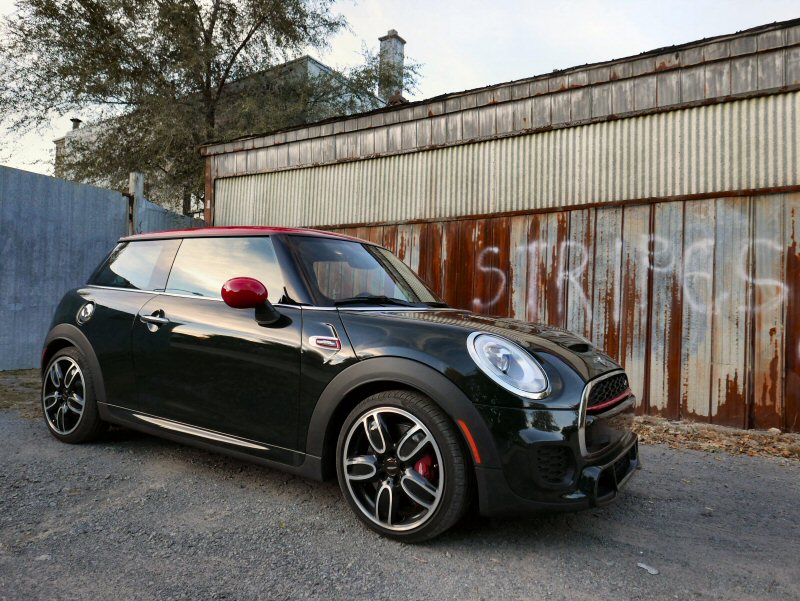
2015 Mini John Cooper Works front 3/4 ・ Photo by Benjamin Hunting
After the debut of the all-new Mini Cooper last year, it was only a matter of time before we were given an equally fresh version of the John Cooper Works high-performance hatchback. The 2015 Mini Cooper John Cooper Works is the most hardcore model in the automaker's portfolio, one that seeks to reach above the more attainable Cooper S and satisfying enthusiasts looking to partake in autocross events or the occasional weekend at the track. Except that’s not all. There's something else lurking under the surface of the John Cooper Works for 2015, and that's the sense that Mini's taken a few bold steps towards smoothing out the rougher edges of previous JCW editions and presenting a Cooper that's every bit as enjoyable as a daily driver as it is when driven at 9/10ths on a road course. I spent a week with the redesigned hot hatch to get a sense of just how much Mini has expanded the John Cooper Works mission.
Make More Room In The Garage
As each of us moves through time, we typically get a little wider and longer in the tooth. The same is true for the 2015 MINI John Cooper Works, which graduates into the bulkier body style first debuted in 2014 by the base Cooper. Don’t think that the car's ballooned out of proportion - it's still got the subcompact flavor that made the original Mini redux such a popular entry-level choice, and it weighs barely a smidgen more than the model it replaces - but the fact that the JCW is wearing the most aggressive-looking body it to ever emerge from the Mini factory goes a long way towards adding muscle to the two-door hatch. The effect is especially apparent up front where no less than five separate intakes have been hewn into the bumper, surrounding the car's gaping grille that is now bisected by a thick black piece of plastic. You also get three more honeycomb grilles at the back, along with a rear spoiler you could probably attach to a hoist and use to lift the entire car.
The more substantial character of the Mini gives heft to its sense of performance purpose, which is finished off by twin tailpipes exiting at the center of the rear bumper.
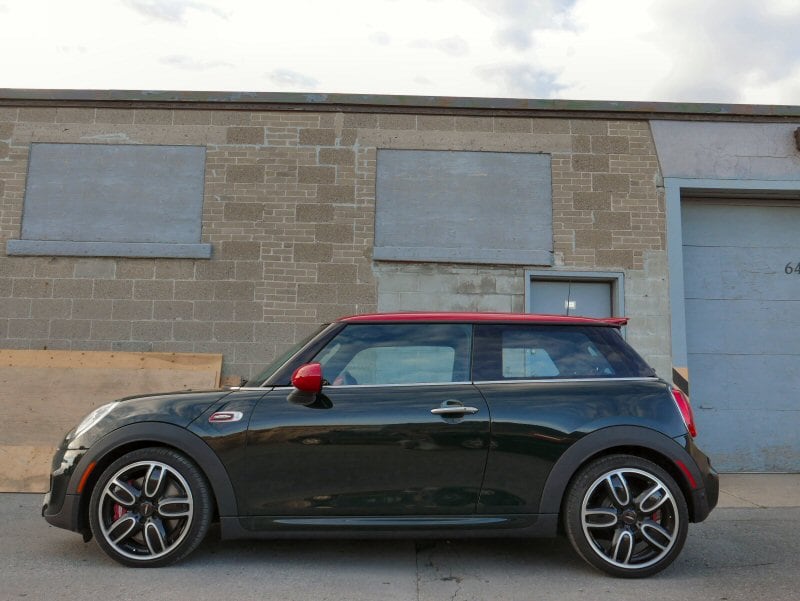
Photo by Benjamin Hunting
Enhanced Aggression Under The Skin, Too
Don't think that the 2015 Mini John Cooper Works' muscles are just for show. Peel back the hatchback's sheet metal and you'll find a host of improvements over the base Cooper, starting with a completely different suspension geometry up front that has been infused with aluminum components to keep chassis weight down. Adjustable dampers are available with the JCW - controlled by a Sport toggle wrapped around the shift bezel - and Brembo brakes provide extra stopping power up front. Incidentally, that Sport setting gives you a louder exhaust note (most perceptible on downshifts, where a 'blat' announces your intentions), and it also enhances throttle response while adding resistance to the Mini's electrically-assisted steering system. Much of this go-fast gear translates into grip, and perhaps my favorite aspect of driving the Mini John Cooper Works was its willingness to pirouette through a corner like a ballerina tied to the maypole. It's a graceful and predictable chassis for a front-wheel drive car, informed by its relative lightness and the square arrangement of its wheels (one at each corner, natch), that lends it remarkable stability despite its small dimensions.
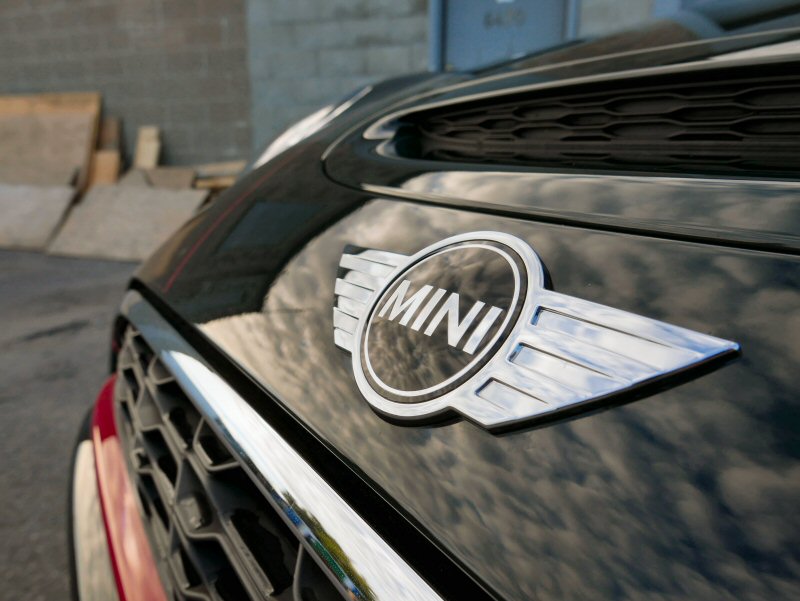
Photo by Benjamin Hunting
New Motor For 2015
Even though the extra mass of the new 2015 Mini John Cooper Works is imperceptible, the automaker has seen fit to banish last year's 1.6-liter turbocharged four-cylinder engine and replace it with a spicier 2.0-liter mill that adds 20 horsepower and 44 lb-ft of torque to the equation. With total output now listed at 228 ponies and 236 lb-ft of torque, the John Cooper Works is far quicker than one would expect, hitting 60-mph in as little as 5.9 seconds on a surface where there's enough traction to satisfy the front tires. I experienced a little torque steer with the throttle down, but Mini's electronic stability control program does a good job of dialling it out to a bare minimum. Aside from a lull off the line, the JCW's turbocharged powerband feels fat where you need it most, which provides a big assist during highway passing and also when trying to keep the engine on the boil for more spirited driving. It's power that's on par or with the posted specs of rivals like the Volkswagen Golf GTI and the Ford Fiesta ST, and it’s a leap forward compared to the 189-horse MINI Cooper S.
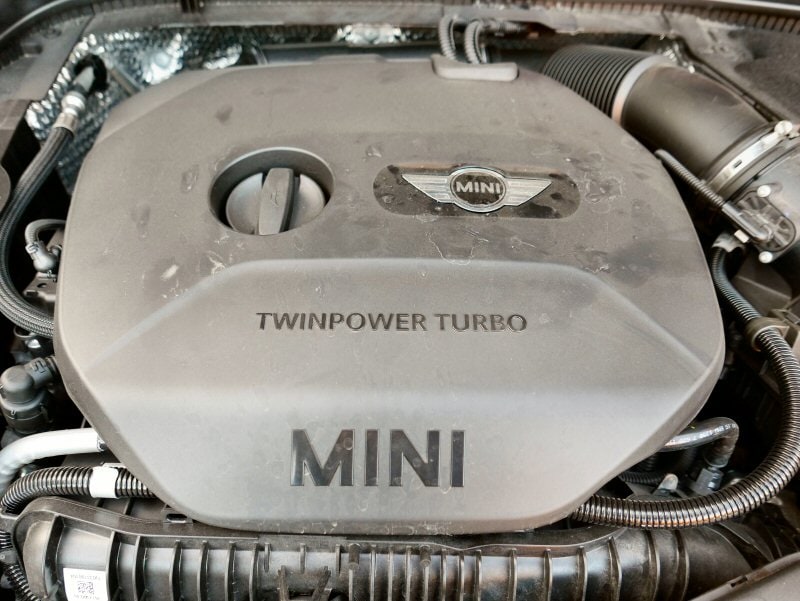
Photo by Benjamin Hunting
If You Really Want It, There's An Automatic Model
You'll notice I so far haven't injected any hyperbolic text about crashing through the gears or clutching out in a frantic spin of rubber and smoke into this review. That would be because I ended up behind the wheel of one of the few (25 percent take rate) John Cooper Works models with an automatic transmission. Certainly, this puts a damper on the car's rambunctious personality - after all, the JCW's image is such that the standard six-speed manual seems like a core part of its DNA - but after I got over my initial disappointment I found a few things to like about the six-speed autobox. Specifically, it does a good job when left to its own devices, especially in Sport mode where shifts are quick and the vehicle rarely, if ever hesitates in searching for the correct ratio. There are paddle shifters on the steering wheel, but they were most useful for showing off the car's exhaust note when coasting down to a stop - and even then, the computer was quick to rap me across the knuckles and deny me a downshift if I hadn’t already entered its overly-conservative range of permissible engine speeds. That 0-60 number I quoted earlier is actually made possible by the six-speed automatic, as the manual is a couple of tenths slower off the line.
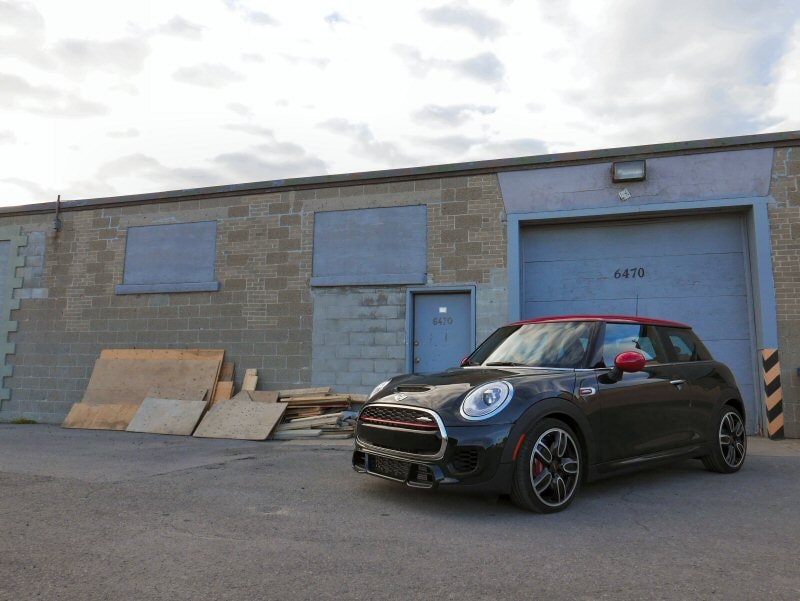
Photo by Benjamin Hunting
Only Wild If You Want It To Be
The 2015 Mini John Cooper Works can be a bit bouncy when set to Sport mode, especially if you've got a car with the adjustable dampers and are dealing with the stiffer shocks on less-than-smooth pavement. What sets the 2015 model apart from its predecessors, however, is the ability to make that (almost) all go away by rotating the drive mode selector back to Normal or Eco modes. In daily driving, the John Cooper Works asks you to tolerate very few shenanigans, displaying admirable poise and composure in a wide variety of on-road situations that make it easy to forget that the car is aimed primarily at performance enthusiasts. Not many affordable sporty cars - especially subcompact models like the Mini John Cooper Works - can pull off this kind of split personality without leaving something important on the table.

Photo by Benjamin Hunting
Reaching For Premium Customers
That smooth-talking side of the 2015 Mini John Cooper Works' character hints at the evolution of the hatchback's status in the eyes of the company's product planners. Whereas once Mini would have been content to release a rough-and-tumble JCW and call it a day, the redesigned model has been clearly earmarked to catch the attention of customers seeking a premium driving experience. As a result, in addition to its power boost, tweaked suspension, and superhero spoiler-cape, the John Cooper Works is also remarkably well appointed inside. It starts at the center of the dashboard where an enormous round bezel illuminates to reflect changes in stereo volume, engine speed, and drive mode. At the center of this circle of light is the brand's trademark orange-hued infotainment system, matched to the left by the pair of round tachometer and speedometer gauges directly in front of the driver. The oval-tastic visual theme is on display throughout the Mini's interior, and, as a result, the cabin feels cohesive rather than pulled from a performance parts bin. The vehicle's sport seats are wrapped in suitably upscale leather hides and accented with bolsters and red stitching that livened up the monochromatic black of my tester's interior, and as long as you are sitting up front you'll feel quite comfortable tooling around in the John Cooper Works. The rear seat is best left to parcels and luggage, as this is still a very small car that can seat more than a pair of passengers only in a pinch.
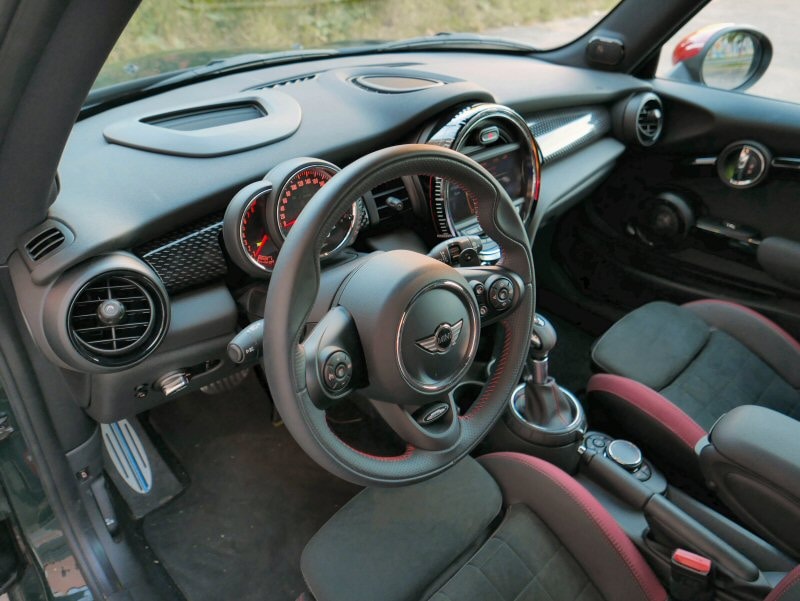
Photo by Benjamin Hunting
Pass/Fail Infotainment System
The circle-within-a-circle infotainment system that comes with the 2015 Mini John Cooper Works is a mixed bag when it comes time to actually use it. Modeled after the iDrive system found in BMW products, on the whole the Mini's interface is easy to suss out, although it does suffer from the same too-many-menus problem as well as a puzzling insistence on showing me the Bluetooth device screen on startup instead of the home screen, or even the last-used screen (such as media controls). Taking the extra step or three required to get anywhere in the Mini's infotainment system wouldn't be so bad if the company hadn’t buried its rotary control knob on the floor behind the shifter. I know that technically Mini considers this area of the car to be the 'center console,' but it's so low to the ground that it's difficult to use without taking your eyes off of the road. Combine that with the buttons that surround the dial and you've got a system that feels more complex to interact with than it really is. I'd love for Mini to raise this panel up, or give us an actual touchscreen to play with so that I can focus more on driving than fumbling to find the MP3 file that I want to play.
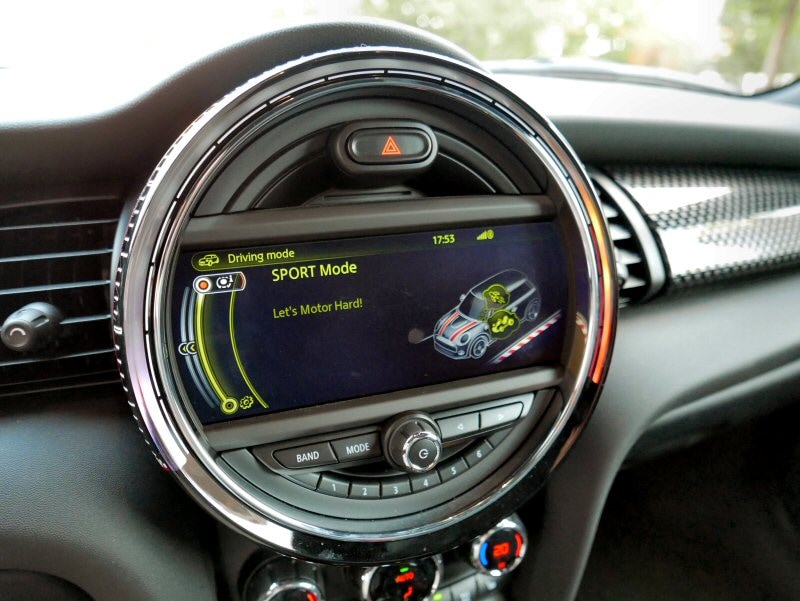
Photo by Benjamin Hunting
Pricing Pushes Up Against Larger, Equally-Quick Hatchbacks
One thing about the 2015 Mini John Cooper Works that's not particularly small is its price. With a starting MSRP of $30,600, the John Cooper Works is quite a bit more expensive than larger, more practical, and as-quick-or-quicker models like the previously-mentioned GTI and the Ford Focus ST, as well as light years beyond the similarly-sized Fiesta ST. From a performance-per-dollar perspective, the JCW simply doesn't work. It lacks the sporting credentials to take on its cheaper foes in instrumented tests, especially if you start adding my tester's options to the mix (rearview camera, enhanced Mini Connected infotainment system, dual-pane sunroof, heated seats, head-up display) and are suddenly looking at a Mini nudging $40,000. Where the car makes more sense is as a near-luxury style accessory, which is part of the next-generation John Cooper Works' evolution. If you start to look at the car's hi-po engine and heavy makeup body kit as badges of conspicuous consumption rather than simply track-ready enhancements, then you begin to get the picture as to where Mini hopes to push its priciest Cooper. A pivot towards premium is an inspired one for the company, especially since it makes it easier to justify JCW editions of larger, heavier, and less motorsports-influenced line-up members like the Countryman.
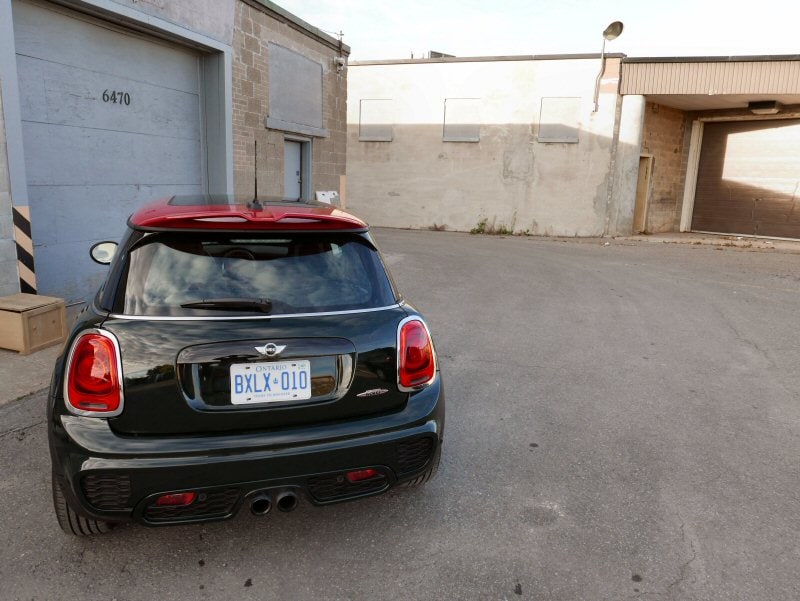
Photo by Benjamin Hunting
2015 Mini John Cooper Works Pros / Cons
Pros: • Looks the business • Spirited acceleration from larger turbocharged engine • Good handling, yet reasonably soft ride in daily driving • Premium feel inside the cabin Cons: • Much more expensive than comparable performance hatchbacks • Tiny rear seat, small cargo area • Fuel economy suffers with your foot down • Clumsy infotainment controls
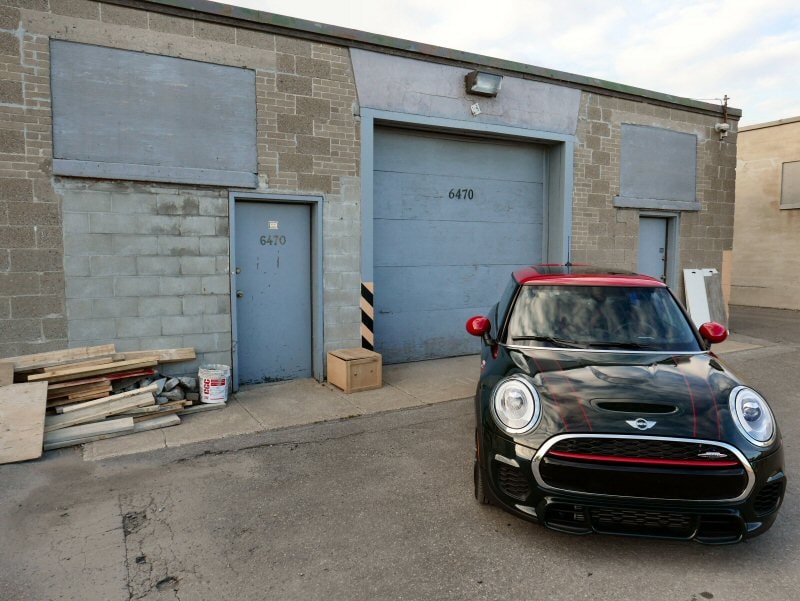
Photo by Benjamin Hunting